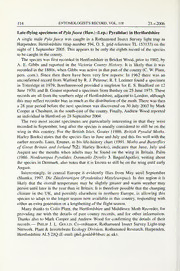
Late-flying specimens of Pyla fusca (Haw.) (Lep.: Pyralidae) in Hertfordshire PDF
Preview Late-flying specimens of Pyla fusca (Haw.) (Lep.: Pyralidae) in Hertfordshire
114 ENTOMOLOGIST’SRECORD,VOL. 118 25.V.2006 Late-flyingspecimensofPylafusca (Haw.) (Lep.: Pyralidae) inHertfordshire A single male Pylafusca was caught in a Rothamsted Insect Survey light trap in Harpenden, Hertfordshire (trap number 594, O. S. grid reference TL 153133) on the night of 1 September 2005. This appears to be only the eighth record ofthe species tobecaughtinthecounty. The species was first recorded in Hertfordshire in Bricket Wood, priorto 1902, by A. E. Gibbs and reported in the Victoria County History. It is likely that it was recorded in the 1880s, when Gibbs was active in thatpart ofthecounty (C. W. Plant, pers. com.). Since then there have been very few reports: In 1962 there was an unconfirmed record from Watford by R. J. Penrose; R. I. Lorimer found a specimen in Totteridge in 1979; Borehamwood provided a singleton for E. S. Bradford on 12 June 1970; and B. Goaterreported a specimen from Bushey on 25 June 1975. These records are all fromthe southernedgeofHertfordshire, adjacentto London, although this mayreflectrecorderbias as much as the distribution ofthemoth. Therewas then a 28 yearperiod before the next specimen was discovered on 30 July 2003 by Mark Cooper at Cheshunt, in the south-east ofthe county. Finally, Andrew Wood reported an individualinHertfordon28 September2004. The two most recent specimens are particularly interesting in that they were recorded in September, long after the species is usually considered to still be on the wing in this country. For the British Isles, Goater (1986. British Pyralid Moths. Harley Books) states that the species flies in June andJuly and this fits well with the earlier records. Later, Emmet, in his life-history chart (1991. Moths and Butterflies ofGreat Britain and Ireland 7(2). Harley Books), indicates that June, July and August are the months when adults may be found on the wing in Britain. Palm (1986. Nordeuropas Pyralider, Danmarks Dyreliv 3. Bpger/Apollo), writing about the species in Denmark, also notes that it is known to still be on the wing until early August. Interestingly, in central Europe it evidently flies from May until September (Slamka, 1997. Die Ziinslerartigen (Pyraloidea) Mitteleuropas). In this region it is likely that the overall temperature may be slightly greater and warm weather may persistuntil laterin the yearthan in Britain. Itis therefore possible that the changing climate in the UK, and possibly elsewhere in northern Europe, is allowing this species to adapt to the longer season now available in this country, responding with eitheranextrageneration oralengtheningofthe flight season. Many thanks to Colin Plant, the Hertfordshire and Middlesex Moth Recorder, for providing me with the details of past county records, and for other information. Thanks also to Mark Cooper and Andrew Wood for confirming the details of their — records. Philip J. L. Gould, Co-ordinator, Rothamsted Insect Survey Light-trap Network, Plant & Invertebrate Ecology Division, Rothamsted Research, Harpenden, HertfordshireAL5 2JQ (E-mail: [email protected]).
